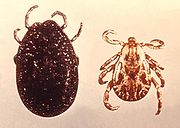
Borrelia anserina
Encyclopedia
Borrelia anserina is a helical filiform
spirochete bacteria
with dimensions of approximately 8-20/0,2-0,3 µm
and with about 5 to 8 spirals. Their mobility is very high. B. anserina can be colored with the May Grunwald-Giemsa method.
)), in anaerobic conditions. They can also be grown in embrionated chicken eggs. The laboratory cultivation of B. anserina is rarely done and constitutes a diagnostic method in bird borreliosis and spirochetosis.
, diarrhea
and severe neurological dysfunctions.

Filiform
Filiform can refer to:*Filiform, a common term used in botany to described leaf shapes.*Filiform papilla on the tongue.*Thread-like crystal formations*A corrosion mechanism...
spirochete bacteria
Bacteria
Bacteria are a large domain of prokaryotic microorganisms. Typically a few micrometres in length, bacteria have a wide range of shapes, ranging from spheres to rods and spirals...
with dimensions of approximately 8-20/0,2-0,3 µm
Micrometre
A micrometer , is by definition 1×10-6 of a meter .In plain English, it means one-millionth of a meter . Its unit symbol in the International System of Units is μm...
and with about 5 to 8 spirals. Their mobility is very high. B. anserina can be colored with the May Grunwald-Giemsa method.
Cultivation
In Microbiological laboratories, B. anserina bacteria can be grown on special protein enriched mediums (rich in ovoalbumins or animal tissue (that contains MyoglobinMyoglobin
Myoglobin is an iron- and oxygen-binding protein found in the muscle tissue of vertebrates in general and in almost all mammals. It is related to hemoglobin, which is the iron- and oxygen-binding protein in blood, specifically in the red blood cells. The only time myoglobin is found in the...
)), in anaerobic conditions. They can also be grown in embrionated chicken eggs. The laboratory cultivation of B. anserina is rarely done and constitutes a diagnostic method in bird borreliosis and spirochetosis.
Pathogenity
B. anserina is a pathogenic agent for birds (chickens, turkeys, ducks etc.) and causes a disease called borreliosis or spirochetosis. This bacteria is transmitted from bird to bird by ticks from the Argas and Ornitodorus genus. The major symptoms of an infection with B. anserina are: anemiaAnemia
Anemia is a decrease in number of red blood cells or less than the normal quantity of hemoglobin in the blood. However, it can include decreased oxygen-binding ability of each hemoglobin molecule due to deformity or lack in numerical development as in some other types of hemoglobin...
, diarrhea
Diarrhea
Diarrhea , also spelled diarrhoea, is the condition of having three or more loose or liquid bowel movements per day. It is a common cause of death in developing countries and the second most common cause of infant deaths worldwide. The loss of fluids through diarrhea can cause dehydration and...
and severe neurological dysfunctions.


